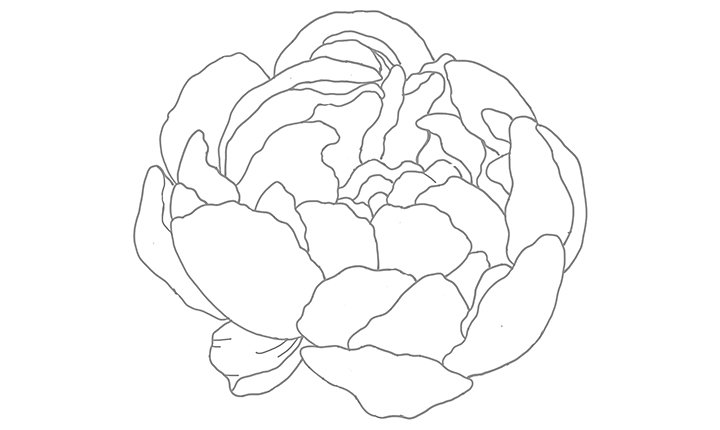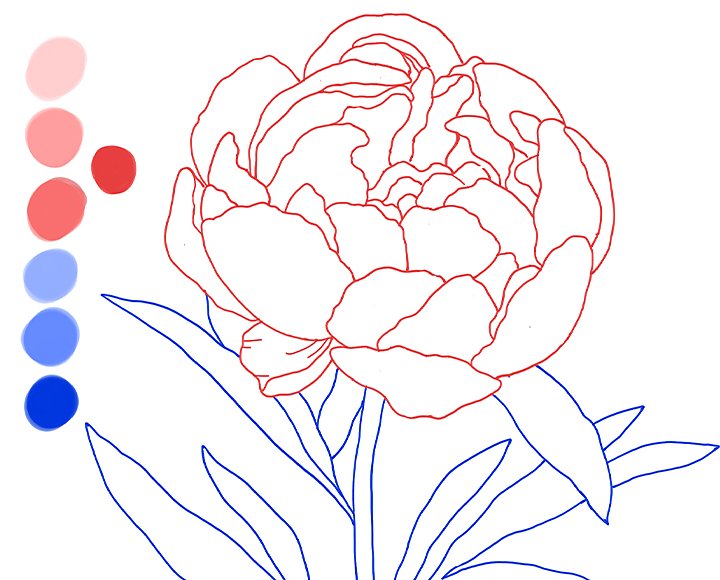Flowe Patch Plan View Drawing
ane. Pick a blossom and a reference image.
Anybody knows what a flower looks like. But how information technology looks out in the world is different from how it looks in a still photo. For example, "One thing I've noticed is that often the stem has a bright highlight in photos. But when people draw flower stems, they often draw them every bit ane large, dark line," says Getsinger. Don't trust your retentivity too much, since factors such as low-cal and shadow tin surprise you. That's where reference images come up into play.
Whether you lot draw a peony or a Queen Anne's lace, you'll need to start with a reference photo. Only don't finish with just i image. "Consider the different life cycles of the plant, the manner it'due south facing the dominicus, or how the light is coming into play," says Getsinger. Gather multiple images, so you amend understand your discipline, merely too don't be afraid to create a composition all your own.

two. Tracing the basic shapes.
When you practise, "trace many types of flowers to learn more about their forms. Start with the major outlines: petals, stems, and leaves," says Lee. "I frequently commencement with basic black-and-white line drawings."
Every complex course can be reduced to simple shapes. Examine how the petals look when lying flat, and so detect how they overlap and become foreshortened in your reference prototype. Don't become bogged downwards in the specific details at this stage. Simply focus on the composition of your prototype and the organic forms.
3. Hone your linework.
From here yous can refine your lines and shapes. Use different line weights to add together master forms and secondary details, and then go in with an eraser to delete unneeded marks from your early sketch. If you're working digitally, like in Adobe Fresco, you tin can create a new layer and turn off your underdrawing afterwards without erasing it.
"Don't focus too much on making the perfect line. Small jitters and imperfections make the petals seem more natural," notes Lee. Focus on the creases and folds within the petals or the hills and valleys around the edges of the leaves. These details tin help add dimension and realism to your drawing.

4. Add some elementary color.
When information technology comes to adding color, give yourself a express palette to begin with. Choose a few main colors for your petals and leaves, and select one or ii shades lighter and darker to use for shadows and highlights. Next, block in the main colors. From there you can layer the highlights and shadows beyond the petals and leaves. When working digitally, go on your colors on a separate layer from your linework. This allows you lot to add texture and edit colors independently.

5. Create dimension with texture.
Refer to your reference images and examine how texture and tone make the flower appear three-dimensional. Apply textured brushes in Adobe Fresco to create light and night marks across the pinnacle and bottom of the petals. Every bit always, continue your calorie-free source in mind when you add particular and shadows.
Get inspired by beautiful flower drawings.
When it comes to flowers, in that location'due south no correct or wrong way to draw them. Spark a few new drawing ideas by seeing how other artists have captured stunning blooms in their ain beautiful drawings.
- Attempt your hand at a looser approach and explore the world of gestural, watercolor flowers.
- Craft a stylized, abstract form like this artist's unexpected rendition of an iris in bloom.
- Take a different arroyo and relax your mind with flower doodles reminiscent of mandalas.
Now that you've got drawing tips and inspiration, you're ready to try it for yourself. Adobe Fresco has live brushes that can help add painterly furnishings to your favorite bloom drawings.
Source: https://www.adobe.com/creativecloud/illustration/discover/how-to-draw-flowers.html
0 Response to "Flowe Patch Plan View Drawing"
Post a Comment